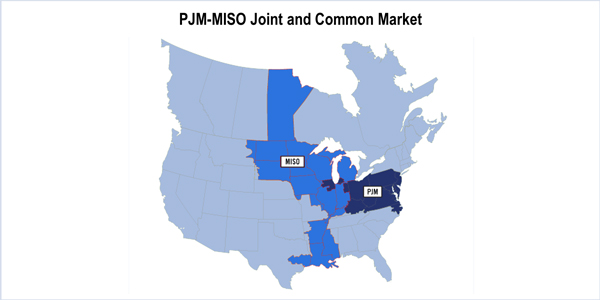By Rich Heidorn Jr.
FERC last week approved changes to MISO and PJM’s Joint Operating Agreement to improve their coordination of pseudo-tied generators, rejecting calls for a technical conference (ER17-2218).
The RTOs said the changes were needed to address the market and reliability challenges resulting from the increased number of pseudo-tied resources. Pseudo-tied volumes from MISO into PJM increased from about 155 MW in June 2015 to 2,160 MW in June 2017.
In November, the commission had accepted PJM’s proposed revisions to the requirements for pseudo-tied resources seeking to participate in the RTO’s capacity auctions (ER17-1138).
The JOA changes specifically affect generation commitment and dispatch “with a focus on reliability assurance,” FERC said. (See MISO, PJM Respond to FERC’s Pseudo-Tie Questions.)
Among the changes:
- The RTOs will coordinate modeling and technical details of pseudo-tied resources;
- To capture the impacts of pseudo-tied resources on flowgates, neither PJM nor MISO nor the entity seeking to pseudo-tie a resource will tag the scheduled energy flows from pseudo-tied resources. Information about the pseudo-tied resources is included in the market-to-market management procedure;
- The RTOs will not recall a pseudo-tied resource that is committed to the attaining balancing authority as a capacity resource to serve load in the native balancing authority;
- The native reliability coordinator can commit, decommit or redispatch the pseudo-tied resource under certain circumstances;
- Entities seeking to pseudo-tie must pay for transmission losses; and
- The RTOs can suspend or terminate a pseudo-tied resource if it no longer satisfies the requirements for a pseudo-tie.
FERC approved the changes over the concerns of intervenors who said it should evaluate them along with issues raised in other pseudo-tie proceedings. MISO’s Independent Market Monitor — which has challenged PJM’s requirement that external capacity resources must be pseudo-tied — said the commission should schedule a technical conference on the issues.
FERC, however, said it agrees with the RTOs that the JOA revisions “are separate and distinct from issues pending in other pseudo-tie related proceedings: These proceedings specifically address administration and coordination of pseudo-tied resources between the RTOs. In contrast, some of the other proceedings pertain more to the agreement that a pseudo-tied resource enters into with the relevant balancing authorities and the requirements for becoming pseudo-tied.”
The commission also rejected as beyond the scope of the proceeding American Municipal Power’s complaint that the JOA revisions won’t help imports from pseudo-tied resources out of MISO into PJM because they don’t resolve the issue of double-charging for congestion. “The parties have made no showing that the provisions filed by the RTOs are unjust and unreasonable because congestion is not addressed,” it said, noting that the RTOs made separate filings on Oct. 23 to address the congestion overlap issue (ER18-136, ER18-137).
FERC dismissed challenges to the RTOs’ proposed non-recallability provision, saying they had “sufficiently delineated the limited circumstances under which a pseudo-tied resource can be committed, decommitted or redispatched by the native reliability coordinator. While we agree that the ability of a pseudo-tied resource to meet its capacity requirement is essential to system reliability, we find that the instant JOA revisions do not inappropriately reduce PJM’s or MISO’s control over a pseudo-tied capacity resource.”





